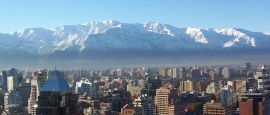Santiago History
Santiago has grown into one of Latin America’s most successful cities.
Santiago was founded in 1541 by a small band of Spanish conquistadors. The location was chosen for its proximity to Cerro Santa Lucía (high ground that could be defended) and the Mapocho River as well as the temperate climate and fertile ground.
But the conquistadores were met with great resistance from the Incas and Picunche who nearly destroyed the town.
By the 1600s, Santiago was taking shape however, and the expansion was rapid. In 1770, the governor commissioned the Metropolitan Cathedral and La Moneda presidential palace to be built.
The Battle of Chacabuco on 12 February 1817 was a key moment in Chilean history. José de San Martín and Bernardo O’Higgins led the resistance army to victory against Spanish royalists and on the same day Chilean independence was proclaimed.
Growth continued throughout the Republican era and an ambitious plan of civic building was formed, leading to the development of the education system and the forward-thinking landscaping of Cerro Santa Lucía.
The railway arrived in 1857. Santiago was now a modern and reasonably wealthy city with trams and paved streets.
By 1940, nearly 1 million people, many immigrants from Spain and Italy, packed the city. Almost as significant as the railway was the connection of the Pan American Highway, which was extended here in the 1960s.
However, Chile suffered from the same poverty as other southern countries. This led to political instability, the key moment being the 1973 coup d’état that saw the liberal president Salvador Allende ousted (fatally) and replaced by the violent military regime of General Pinochet.
Santiago was the scene of horrific atrocities against those perceived to be anti-Pinochet. Unlike the regime in Argentina, Chile’s government began to look west, opening up ties and trade with Thatcher’s Britain and Reagan’s USA.
Today, Santiago is a modern and lively place, leading one of Latin America’s most prosperous countries.
Did you know?
• The city was originally named Santiago de Nueva Extremadura.
• An earthquake in 1647 levelled the city.
• Around a third of the country’s population lives in Santiago.
Do you have any Feedback about this page?
© 2025 Columbus Travel Media Ltd. All rights reserved. No part of this site may be reproduced without our written permission, click here for information on Columbus Content Solutions.




 You know where
You know where